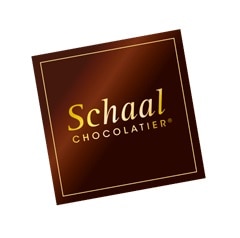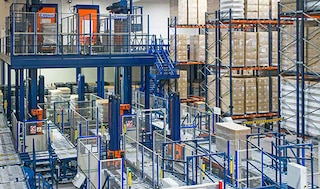
Schaal Chocolatier automates its supply chain in France
The warehouse, expertly connected to the production center, dispatches between 180 and 240 pallets each day

Starting with the cocoa bean, making chocolate is an artisanal process that requires time, patience and precision. Schaal Chocolatier has a long history of producing and selling high-end chocolate bonbons. This tradition differs from its modern center in Geispolsheim, in Eastern France, fitted out with the latest in cutting-edge technology. Tradition and technology have formed an unbeatable partnership to produce the highest quality chocolates and those which satisfy even the most demanding palates.
Traditional methods, better techniques
In 1871, Monsieur Schaal established his business in Strasbourg. The bonbons made here were highly successful and in short order started being sold in most of stores throughout France.
In 1967, the Burrus family bought the company. Three years later, they built some new installations in the town of Geispolsheim, on the outskirts of Strasbourg, to deal with increased production and future growth. Indeed, since then, the company has not stopped growing and its product line is continually expanding to offer hundreds of delectables for any taste, like chocolate balls, eggs, figures and bonbons.
Currently, Schaal Chocolatier is one of the leading companies making luxury chocolates and has become a benchmark for professionals in this sector. With more than 250 employees, it exports its products all over Europe, the United States and Japan. Schaal Chocolatier has a true passion for chocolate. The company set the bar high for the quality of its products and, as such, chooses the best ingredients, applies hard-earned knowledge and, also, uses industrial methods that ensure its texture and delicious flavor.
Raphael Dorbeau, the Methods Department Manager, explains that “previously, we would store our finished products and semi-finished ones inside the production center. The main drawback is that the installation’s temperature fluctuates a lot during different times of the year. So, the chocolates must be stored in a controlled temperature to guarantee their qualities.”
The company needed to free up space in its production center in order to increase the pace of production. Moreover, “we are thinking about setting up new production lines for Groupe SALPA (that includes Schaal Chocolatier),” pointed out the company’s methods department manager.
Automation: speed and tracking
Recently, Schaal Chocolatier opened a new 21,528 ft2 warehouse connected to its Geispolsheim production center. One of its most eye-catching features is that operations are automatic and forego the workers who normally handle the products. “We wanted to avoid using standard forklifts run by operators to handle the goods,” mentions Dorbeau.
Operations standout for their simplicity: product inputs and outputs are done through a conveyor circuit and a transfer car that distributes pallets in the aisles assigned to them by the WMS.
Once in the aisle, the stacker cranes are tasked with slotting and extracting pallets from their specific locations. These machines, which move at travel speeds of 394 ft/min and125 ft/min when raised, work an average of 16 hours a day, five and six days a week.
The automatic solution yields many advantages for the chocolate company. For example, better hygiene, operational cost savings, faster goods management, product control and, ultimately, a significant increase in productivity.
Raphael Dorbeau highlights that the control over the goods “has sped up the preparation of production orders and picking, has ensured FIFO storage is practiced and has allowed tracking of product statuses anytime we want.”
Chocolate is a seasonal product. In other words, it is consumed at certain times of the year (especially during Easter and Christmas). The warehouse is set up to deal with these changes in demand. Between March and August, the company distributes an average of 180 pallets a day from the warehouse. Meanwhile, between September and February, this cipher rises to 240 pallets a day.
Raphael Dorbeau - Methods Department Manager at Schaal Chocolatier
“Our products are not homogenous and, for this very reason, they are set on top of wooden and plastic pallets that are 32" x 48" and 39" x 48" in size. The Interlake Mecalux stacker crane is configured to handle these unit loads. And, it fulfills the cycles needed to satisfy our customers.”
Warehouse features
The warehouse is 52' tall, divided into eight levels, and comprises five aisles of single-depth racking along each side that, overall, provide capacity for 6,200 pallets. “Of the five aisles, the first works at 57.2 ˚F to house semi-finished products and utensils needed for day-to-day work. The other three are used to store finished products, raw materials and packaging. The fifth and last aisle runs at 41 ˚F and also manages finished products and raw materials,” says Catherine Rimlinger, Manager of the Production Supplies Department at Schaal Chocolatier.
The production center is located just next to the warehouse. This building stands four floors high —each of which is allocated to a different process— and expertly linked to the warehouse. By doing so, exits and entries of the goods speed up, causing no interruptions in any processes that might be taking place.
On the bottom floor, picking stations were enabled next to the loading docks. There, operators receive products flowing from the warehouse and take charge of sorting them according to the order to which they correspond.
Easy WMS: ready to grow
A large-sized warehouse and with an automated operation, like is the case at Schaal Chocolatier, requires an efficient warehouse management system that directs everything seamlessly and prevents incidents from happening. The company has deployed the Easy WMS of Interlake Mecalux for the purposes of getting the best possible results out of its new installation.
Easy WMS contains algorithms and parameterizable rules to assign a location to the merchandise with its features in mind. Firstly, it must be decided if something should be inserted into the aisle that operates at 57.2 ˚F, or the one that runs at 41 ˚F. The system also evaluates the demand level to establish an accessible location or one that is further from the entrances and exits.
In the words of Catherine Rimlinger, “other than the Geispolsheim automated warehouse, we also use Easy WMS in our traditional warehouses to ensure pallet inflows and outflows.”
Catherine Rimlinger - Manager of the Production Supplies Departmentat Schaal Chocolatier
“In our installations, there must be very strict control of the chocolates. In that respect, we are very satisfied with Easy WMS because it is capable of real-time inventory control, meaning we can keep track of stock levels and statuses around the clock, know where goods come from, where they are specifically located and where they are going.
Advantages for Schaal Chocolatier
- Freed up production center space: previously, the finished products and semi-finished ones were housed in the plant. With the new warehouse, the company repurposed space to install new production lines.
- Better goods control: in the automated warehouse, the status of more than 6,200 housed pallets can be tracked at any moment. Bonbons are stored in an aisle that runs at a controlled temperature to keep them in top condition and guarantee their quality.
- Increased productivity: the warehouse, fully connected to the production center, produces an outstanding number of movements. Daily, they ship out between 180 and 240 pallets.
| Automated warehouse of Schaal Chocolatier | |
|---|---|
| Storage capacity: | 6,200 pallets |
| Pallet sizes: | 32" / 39" x 48" |
| Max. pallet weight: | 1,764 lb |
| Rack height: | 52' |
| Rack length: | 276' |
Gallery

The automated warehouse of Schaal Chocolatier in France
Ask an expert







